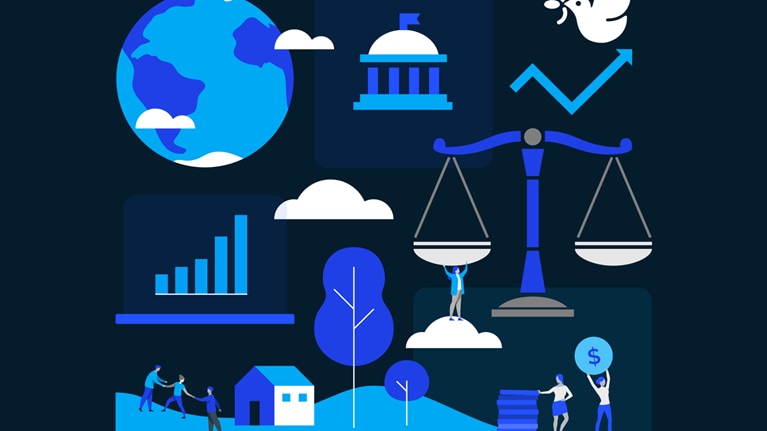The free-market economy is one of the most important reasons for the wealth creation and improved quality of life humanity has enjoyed in recent generations. In 1950, for example, Norway had the world’s highest life expectancy (72.3 years). Now the global average is higher (72.6 years) and in Africa, where it is lowest, it is rising fastest. In China and India alone, more than 1.2 billion people have lifted themselves out of extreme poverty since their countries began to shift their economic policies toward more market-oriented principles.
None of this could have been done without economic growth. And that is what free-market-oriented economies, in their many different varieties, have delivered better than the alternatives. Think of West Germany versus East Germany; South Korea versus North Korea; or Costa Rica versus Cuba.
And yet, there is palpable anger and distrust with the idea of capitalism and the role of business in many societies.
One such indicator is increased political polarization in many countries, even in well-established democracies. Economic issues are often—and perhaps always—a source of such discontent. Another indicator is the most recent Edelman Trust Barometer.1 Published in January, shortly before the COVID-19 pandemic changed the world, the report includes a survey of 34,000 people of which 56 percent believed that capitalism was doing more harm than good globally, with majorities in 22 of 28 markets surveyed.
As economic players, business people cannot stand offstage, watching the action—and the same survey found that people don’t want them to. Ninety-two percent of respondents said that companies should be speaking out on issues such as training, automation, and immigration, with 74 percent pointing to CEOs to take the lead. With the onset of COVID-19 and the wealth of information available, even those who would like to stay out of the action will find that, more and more, their employees and customers are demanding otherwise. The business ecosystem is evolving; those who resist will find themselves not only on the wrong side of history, but also at a competitive disadvantage.
An opportunity for positive change
Business leaders should embrace the apparent contradiction—of low trust and high expectations—and make the choice to demonstrate that they see their mission as serving not only shareholders but also customers, suppliers, workers, and communities. The common term for this is “stakeholder capitalism” and we think its time has come.
Many CEOs say they agree—at least theoretically. There are certainly examples of businesses just talking the talk and not following through. But that is not a good idea, for two reasons. First, many companies are making public commitments. Their progress, or lack of it, can be tracked, measured, and followed-up on. And given the plethora of information available, even those who do not make such commitments can be named and shamed when their actions fall short of expectations.
Second, there is growing evidence that companies that take a long-term view—and stakeholder capitalism requires that—perform better. In a study that looked at 615 large- and mid-cap US publicly listed companies from 2001–15, the McKinsey Global Institute found that those with a long-term view outperformed the rest in earnings, revenue, investment, and job growth. Other McKinsey research concluded that companies with strong environmental, social, and governance norms recorded higher performance and credit ratings through five factors: top-line growth, lower costs, fewer legal and regulatory interventions, higher productivity, and optimized investment and asset utilization.

WATCH
A McKinsey Live event on ‘Purpose vs PR: how business can find meaning in the COVID-19 era’
What to do
So how can companies walk the talk? For more than a year, McKinsey has been asking that question of business leaders in a variety of sectors, as well as of activists, academics, and employees. We have also reviewed the relevant research, and are undertaking our own.
We start from two premises. First, that serving all stakeholders is an ethical good that can also be a source of competitive advantage. And second, to do this successfully, companies must be profitable. There is a term for an enlightened company with the most perfect intentions that does not make money: defunct.
On that basis, we have identified five principles for businesses to make stakeholder engagement a reality.
Principle 1: Get the board on board
Experience can be a tough teacher, but an effective one. Companies have learned the hard way that installing a chief innovation office doesn’t mean that great ideas will start flowing nor is it necessary that hiring a chief digital officer will wake up the C-suite from its analog slumber. For stakeholder engagement to become real, commitment needs to start from the top—that is, the board. Boards are responsible for the long-term interest of the company; it is their role to define its mission and purpose. It’s easy for CEOs to make soothing pledges; however, in the absence of support from the board, nothing will change, as it is the board that sets and governs strategy.
In this regard, there are two distinct but complementary approaches to consider. One is to appoint new board members with a diversity of experience, skills, and interests who can reflect the concerns and priorities of a wider range of stakeholders, rather than shareholders alone. That might mean inviting in nonprofit leaders, local government officials, or consumer groups. An educational charity with which one of us is involved has done exactly this and seen impressive stability over the past 15 years. That is essential for the group to serve its purpose—and also for businesses that want to take a longer-term view.
The other approach is to change corporate governance guidelines to clearly assert stakeholder, rather than explicitly shareholder, priority. We know that in some jurisdictions, this may not be legally possible.2 Where it is, however, there can be no stronger signal. And without it, it is fair to question the depth of a company’s convictions.
Anglian Water Services is a UK-based company that supplies water to 2.5 million households. In 2019, it became the first utility company to embed public interest at its core. Independent directors, together with their investors, rewrote the British utility’s Articles of Association, which governs how the business is run. The legally binding document now states that the company’s purpose is “to conduct its business and operations for the benefit of members as a whole while delivering long-term value for its customers, the region, and the communities it serves and seeking positive outcomes for the environment and society.” A director is explicitly required to act “in the way he or she considers, in good faith, would be most likely to promote the purpose of the company.” The company is bringing in independent evaluators to measure to what extent it is living up to its principles and has also set out five specific, measurable goals to reach by 2030, including leak reduction, affordability, and net-zero emissions.
We understand, of course, that changing corporate governance guidelines is no easy task. As an interim step, it should at least be possible for boards to institute “listening sessions” to hear from employees, community leaders, and outside experts.
Principle 2: Set and track environmental goals
A core principle of business is that what gets measured, gets managed. So companies with a stakeholder ethos should commit to putting their principles into practice by publishing concrete, achievable, and measurable goals. This approach is particularly apt in relation to the environment, where there are clear and readily measurable metrics to track; factors such as “community engagement” may be important but are also less empirical.
So far, the record shows that in many cases, companies that have made environmental sustainability a priority have found that it is also good for the bottom line, by reducing energy costs, for example, or by cutting the cost of packaging. Improving environmental performance is a marathon; it requires training and commitment. Publishing specific targets is a way for companies to show that they are committed to putting in the miles.
While the conventional oil and gas industry is not particularly well regarded by many green groups, a number of the majors show how setting and tracking environmental goals can be done. At bp, the publicly-stated ambition is to be a net-zero-emissions company by 2050 or sooner. It has set out ten specific carbon aims, with incentives to employees to reach them. There are intermediate targets to watch, such as installing methane measurement tools at all sites by 2023—and bp regularly publishes its data.
Shell, the Anglo-Dutch oil company, has the same “net-zero emissions by 2050” goal. To get there, it is doing things like using flying drones to spot methane emissions, buying offsets, using solar to power at lubricants plants, and investing in carbon capture and storage. Shell tracks a wide variety of metrics, ranging from spills and leaks to flaring and safety events, and it reports on its progress every year. Bonuses are linked to greenhouse-gas-emissions improvements.
Such efforts are not unique to Western firms. Nigeria’s Seplat, a small independent oil and natural gas company listed on the London and Nigerian stock exchanges, operates in the environmentally sensitive Niger Delta. Since 2015, it has sharply lowered its use of fresh water and since 2011, has reduced the incidence of spills by 80 percent and has recorded lower rates of flaring and accidents—even as it cut operating expenses and increased production.
In an example from an entirely different industry, consider Brazil’s Natura &Co, the fourth-largest cosmetics group in the world. Founded in 1969, its brands include Aesop, Avon, Natura, and The Body Shop, and it has become a global corporate environmental leader. An early adopter of the “triple bottom line,” publishing results on social and environmental metrics as well as financial ones, it has been carbon neutral since 2007. In 2010, Natura introduced refill packaging made of sugarcane ethanol. In 2014, it became the first South American public company, and one of the largest in the world, to be certified as a B (for “benefit”) Corporation; certified companies are “legally required to consider the impact of their decisions on their workers, customers, suppliers, community, and the environment.” (Aesop is also a B Corp.) And earlier this year, it pledged to reach net-zero carbon emissions by 2030. Customers have responded to its efforts, with revenues growing an average of almost 12 percent a year from 2009–19.
Finally, Ørsted is Denmark’s largest energy provider. In 2008, when it was known as DONG Energy, coal was the source of 85 percent of its power. To illustrate how it can make good business sense to get ahead of social and regulatory trends, the next year, Ørsted introduced a ten-year plan to transform the company so that it would be 85 percent renewable by 2019. Year by year, company reports showed how the balance between coal and renewables was shifting, and it completed the plan a year ahead of schedule. The new goal: to reduce emissions 98 percent from 2006 levels by 2025. The shift has generated positive returns: from 2009–19, revenues rose by 43 percent; earnings before interest, taxes depreciation, and amortization have risen by 140 percent; and enterprise value has increased by 471 percent over the period.
Principle 3: Work with suppliers, old and new, to build capabilities and skills
Even companies that are sincere in their efforts can play a powerful, if indirect, role in social or environmental damage via their supply chain. One way to limit such damage is to leverage their expertise and economic clout to improve the practices of subcontractors and suppliers. The principle is clear—a company’s sense of responsibility must go beyond its direct operations—not only in economic and environmental terms, but also regarding its impact on consumers, contractors, and their employees. Starbucks, for example, checks that its suppliers are paying their workers the minimum wage, do not employ children, and conserve biodiversity. During the COVID-19 outbreak, a number of companies have been paying their suppliers early, or extending credit, to keep them going.
In 2017, Walmart established Project Gigaton, with the goal of avoiding a billion metric tons of greenhouse gases from its supply chain by 2030. To get there, it has pursued a wide variety of initiatives, such as participating with some US-based suppliers on power-purchase agreements from renewable sources, bringing economies of scale to cut costs.3 The effort has engaged more than 2,000 suppliers around the world, and progress is tracked, both collectively and individually. Three years in, the retailer is almost a quarter of the way toward the goal. It also trains and monitors suppliers to ensure fair labor practices, and has cut off dozens that have systematically failed to comply with its standards.
Unilever, the global consumer-goods company, began developing its Sustainable Living Plan in 2010. One element set a goal of sourcing 100 percent of its agricultural raw materials sustainably by 2020. The Sustainable Agriculture Programme (SAP) monitors 11 social, economic, and environmental indicators, including soil health, biodiversity, and human capital. SAP also sets minimum standards for its suppliers, such as those related to deforestation and human rights. To do so, it first focused on important crops, such as palm oil, sugar, and tea, and then worked with suppliers to develop ways to address the key issues. For example, Unilever requires all palm oil suppliers—and their suppliers, too—to comply with the “five principles for sustainable palm oil.” By 2019, Unilever estimated that 62 percent of its agricultural supply chain was from certified sustainable sources, up from 14 percent in 2010.

Five Fifty: High stakes for stakeholder capitalism
Principle 4: Serve consumers’ long-term needs
The internet spreads culture and information, but also vile lies. Paint can be used to daub insults as well as to make great art. Cars move goods and people—and can crash. The point is that almost any product can do harm through poor use, malign intentions, or sheer bad luck. And while business does not want to overstep its bounds, it also does not want to be indifferent to predictably bad outcomes. Recognizing how goods and products affect consumers and then taking action to reduce the negative consequences is part of stakeholder capitalism.
Take food, for example. Eating is something people enjoy, and it is also, obviously, a necessity. But people do not always think about what they eat—which is one of the reasons that global obesity rates almost tripled between 1975 and 2016, according to the World Health Organization, portending all the health consequences that implies. In response, a number of major companies have made changes in how they formulate their food. For example, the Swiss food giant Nestle has reduced the amount of sugar used in its breakfast cereals and also added whole grains and vitamins.
As another example, the family-owned LEGO Group’s ubiquitous interlocking bricks (which parents all over the world have tripped over since their introduction in 1958), are loved by children. But the company sees its mission as not only amusing children but also helping them develop into “the builders of tomorrow.” The LEGO Foundation’s Centre for Creativity, Play, and Learning, which gets 25 percent of company profits, researches the role of play in childhood development and creativity and sponsors programs for children—1.8 million of them in 2019—to teach emotional and cognitive skills through play. LEGO can undertake this kind of venture because it is commercially successful. After a rough patch in the early 2000s, it recovered well; revenues more than tripled from 2009–19, while profits are strong and steady. LEGO is successful because it is not afraid to change. While the bricks are still the staple, new products make up more than half the portfolio every year, developed in part through intense collaboration with consumers—that is, kids—from all over the world.
Principle 5: Treat your employees with respect and invest in their futures
Labor is not just a cost to be managed. Employees are human beings and on that basis alone, should be treated with dignity. In business terms, they are also an incredibly valuable resource, well worth tending to in the present and investing in for the future. Companies that do so could benefit in the long term, by being more attractive to possible hires, and inspiring greater loyalty and productivity among those they already employ.
With about 50,000 employees, California-based Salesforce is the world’s largest customer relationship management company. It regularly appears on lists of “best companies to work for” because of its high level of commitment to its staff. For example, it offers them seven paid days off per year to volunteer in their communities. In the office (virtual or physical), employees can use specially developed tools to resolve internal queries. As befits a tech company—Salesforce uses data to improve on the employee experience. At every stage of an employee’s career, data points are used to make better, faster talent decisions. Additionally, the company invests heavily in workforce development. Employees clearly are buying in: more than half of new hires4 come from internal referrals. And there is more to come: in September Salesforce announced that it would hire 12,000 new employees in the next year.
Mondragon is a worker–owner cooperative in the Basque region of northern Spain that is one of the country’s largest businesses, with revenues of €12 billion and more than 81,000 employees. Mondragon prides itself on the principle of “intercooperation,” which means that when one constituent of the co-op falters, the others step in to help. When Fagor Electrodomésticos, a part of the Mondragon co-op, went bankrupt in 2013, it had 1,800 employees. Instead of immediately turning to layoffs, Mondragon reskilled them so that almost all of them were able to move to other parts of the business. Mondragon’s commitment to its employees is reflected back—productivity is 8 percent higher than and its absentee rate half that of its peers.
Finally, Haidilao is a popular Chinese hot pot restaurant chain, with hundreds of restaurants—mostly in China, but also in Canada, Japan, Southeast Asia, and the United States. It is known for the quality of its customer service and its staff loyalty—and management insists that the two go hand in hand. Branch managers are evaluated not on revenues but on metrics associated with customer and employee satisfaction. Some restaurants offer on-site babysitting; others, free manicures and shoe polishing. Customers waiting in line get snacks and games. Employees have significant autonomy; for example, they are allowed to gift a customer a complimentary meal without managerial sign-off. There is also a wide range of perks, including a dedicated fund to help employees with personal emergencies. In a sector notorious for high turnover—40 percent a month, in 2015 (the last year for which data were available), Haidilao’s was 10 percent, and among management, near zero. Because it promotes only from within, employees believe they can advance, maybe by attending the Haidilao College or taking a variety of training courses related to restaurant management. And when the company suffered a food-safety crisis in some of its Beijing locations, it responded with an apology and installed live-streaming cameras so customers could see the kitchens. “Putting faith in my staff has paid off for me,” Haidilao’s founder and CEO Zhang Yong told a conference in 2018. “Giving them responsibility and autonomy is how you show trust.”
Companies that embrace the idea of stakeholder capitalism—an orientation that we think can apply to a wide range of business models, including startups and small and medium-size enterprises—may have to deal with backlash. Short-term-oriented investors may believe their returns are suffering. Employees could be irritated if they believe their expectations are not being met. Competitors will be happy to jump on any bad news.
And for some people, nothing a company does will be enough. There have been, and will be, cases where companies announce and try hard to reach specific stakeholder goals—and then fall short, facing disapproval for their failure. Imperfection is a fact of life and, certainly, of business.
Making stakeholder capitalism work, then, is a matter of striking a delicate balance among competing priorities; after all, fair is not always equal. Companies need to be ready to change their answers because the questions certainly will change. Real progress will take time. And yes, business may blunder. But that doesn’t mean the journey is not worthwhile.
We believe, as many business leaders do, that a company is more than a balance sheet. It is an expression of human bonds, a living entity that is sown and grown and whose harvest is lives and livelihoods. Stakeholder capitalism is a way to plant those seeds.



